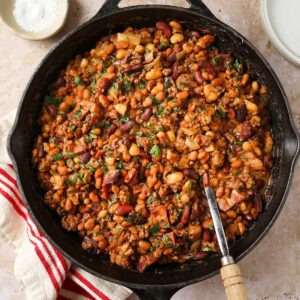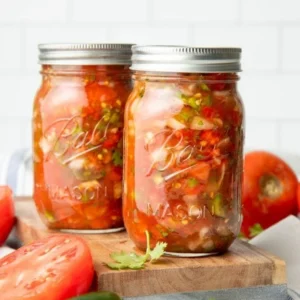White gravy is a rich, creamy sauce commonly served in Southern cuisine and other comfort food dishes. It is typically made from a roux (flour and fat), milk, and seasoning. The gravy is especially popular in the United States, where it’s a beloved addition to dishes like biscuits and gravy, fried chicken, and mashed potatoes. Its creamy texture and savory flavor make it a staple in many homes. White gravy is so versatile that it can be used on a variety of meals, from breakfast to dinner.
The simplicity of the recipe, combined with its ability to elevate simple dishes, is what makes it so popular. The delicate flavors balance perfectly with the crispy textures of fried foods or the smoothness of mashed potatoes.
Ingredients
- 2 tablespoons butter
- 2 tablespoons all-purpose flour
- 2 cups whole milk (can substitute with dairy-free milk for a vegan version)
- Salt, to taste
- Black pepper, to taste
- 1/4 teaspoon garlic powder (optional)
- 1/4 teaspoon onion powder (optional)
Possible Substitutions:



- Butter: Can be substituted with olive oil or margarine for a dairy-free version.
- All-purpose flour: If you’re gluten-sensitive, you can use a gluten-free flour blend instead.
- Whole milk: For dairy-free alternatives, opt for oat milk or almond milk.
Step-by-Step Cooking Instructions
-
Melt the butter: In a medium saucepan, melt the butter over medium heat until it starts to bubble, but not burn.
-
Make the roux: Stir in the flour gradually, whisking constantly to avoid lumps. Cook the flour for about 1-2 minutes until it becomes a golden brown color. This step is crucial for flavor development.
-
Add milk: Slowly pour in the milk, whisking continuously to keep the sauce smooth. Be sure to scrape the sides and bottom of the pan to prevent the flour from sticking.
-
Season: Add salt, pepper, and optional garlic and onion powders. Continue to stir, and bring the mixture to a simmer. Allow it to thicken, which should take about 3-5 minutes.
-
Check consistency: If the gravy becomes too thick, add more milk, a little at a time, until you reach your desired consistency.
-
Taste and adjust: Taste the gravy and adjust the seasonings if needed. If you like a thicker gravy, let it cook longer. If it’s too thick, add more milk gradually.
Pro Tips and Cooking Techniques
- Whisk constantly: The key to avoiding lumps is to whisk the mixture constantly when adding the milk to the flour-butter mixture. This ensures a smooth, velvety gravy.
- Control the heat: Keep the heat medium to avoid burning the flour. If the gravy starts to bubble too aggressively, lower the heat to a simmer.
- Flavoring options: You can add herbs such as thyme or rosemary for a different flavor profile. Fresh herbs can be added towards the end of cooking for a fragrant finish.
Variations and Customizations
- Vegetarian White Gravy: Simply substitute the butter with plant-based butter and use non-dairy milk.
- Spicy Version: Add a pinch of cayenne pepper or a dash of hot sauce to give the gravy a spicy kick.
- Low-Carb Version: Use almond flour instead of regular flour for a low-carb alternative.
- Regional Twist: In some Southern recipes, sausage drippings are used in place of butter for a savory and meaty flavor. If you prefer a meaty version, crumble cooked sausage into the gravy for a delicious variation.
Serving Suggestions
- Classic Pairing: Serve the white gravy over fresh, warm biscuits for a classic Southern breakfast.
- Mashed Potatoes: Pour it generously over creamy mashed potatoes for a comforting side dish.
- Fried Chicken: It pairs beautifully with crispy fried chicken, adding moisture and richness to the dish.
- Crispy Bacon: Sprinkle crumbled bacon on top of your white gravy for an extra layer of flavor and crunch.
Nutritional Information (Approximate per serving)
- Calories: 90-120 kcal
- Protein: 3g
- Carbs: 8g
- Fats: 6g
- Fiber: 0g
- Sugar: 5g
Note: Nutritional information is approximate and varies based on the ingredients used.
Frequently Asked Questions (FAQs)
Q: Why is my white gravy lumpy?
A: Lumpy gravy often happens if the flour isn’t fully whisked into the butter or if the milk is added too quickly. To avoid this, make sure you whisk constantly and add the milk slowly.
Q: Can I make white gravy in advance?
A: Yes, white gravy can be made ahead of time and stored in an airtight container in the fridge for up to 3 days. Reheat on low heat, adding a little milk to thin it out as it may thicken when stored.
Q: How do I fix too-thick gravy?
A: If your gravy is too thick, simply add more milk, a tablespoon at a time, until the desired consistency is reached.
Closing Thoughts
White gravy is a timeless dish that adds comfort and flavor to any meal. It’s versatile, easy to make, and can be customized to suit various dietary needs and preferences. Whether you’re serving it with biscuits, potatoes, or fried chicken, this creamy gravy is sure to elevate your meal.



